Ultraviolet lamp for home use: types, how to choose, which manufacturer is better
The life of people, plants and animals is in close connection with the Sun.It emits radiation that has special properties. Ultraviolet light is considered irreplaceable and vital. With its deficiency, extremely undesirable processes in the body begin, and a strictly dosed amount can cure serious diseases.
Therefore, an ultraviolet lamp for home use is necessary for many. In this article we will talk about how to choose it correctly. Why consider the features of UV rays and their need for the human body.
Let's get acquainted with the types of UV lamps, their characteristics, and provide recommendations for choosing the appropriate option for household use.
The content of the article:
Why is ultraviolet necessary?
Ultraviolet radiation is radiation that is invisible to humans and occupies the region between the X-ray and visible spectrum. The lengths of its constituent waves range from 10 to 400 nanometers.
Physicists conditionally divide the ultraviolet spectrum into near and far, and also distinguish three types of rays that make it up. Radiation C is classified as hard radiation; with relatively long exposure it can kill living cells.
It is practically never found in nature, except high in the mountains.But it can be obtained under artificial conditions. Radiation B is considered to be of medium hardness.
This is what affects people in the middle of a hot summer day. If used excessively, it can cause harm. And finally, the softest and most useful are type A rays. They can even cure a person from some diseases.
Ultraviolet has wide applications in medicine and other fields. First of all, because in its presence the body produces vitamin D, which is necessary for the normal development of a child and the health of adults. This element makes bones stronger, strengthens the immune system and allows the body to properly absorb a number of essential microelements.
In addition, doctors have proven that under the influence of ultraviolet radiation, serotonin, the hormone of happiness, is synthesized in the brain. This is why we love sunny days so much and fall into a kind of depression when the sky is overcast. In addition, ultraviolet light is used in medicine as a bactericidal, antimyotic and mutagenic agent. The therapeutic effect of radiation is also known.

Strictly dosed rays directed at a specific area give a good therapeutic effect for a number of diseases. A new industry has emerged - laser biomedicine, which uses ultraviolet light. It is used to diagnose ailments and to monitor the condition of organs after operations.
UV radiation is also widely used in cosmetology, where it is most often used to tan and combat certain skin problems.
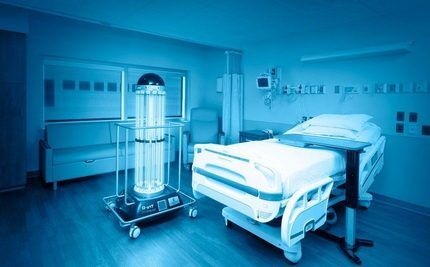
Do not underestimate ultraviolet deficiency. When it appears, a person suffers from vitamin deficiency, immunity decreases and malfunctions in the functioning of the nervous system are diagnosed.
A tendency to depression and mental instability develops. Taking all these factors into account, household versions of ultraviolet lamps for a wide variety of purposes have been developed and are being produced for those interested. Let's get to know them better.
Main types of UV lamps
Practice shows that ultraviolet emitters are most often purchased for home use for disinfection purposes. Hard rays in the range of 100 to 320 nm have been proven to effectively kill microorganisms.
They destroy bacteria and mold spores, even those that are in an inactive dormant state. The radiation kills the eggs of exoparasites, dust mites, and insects.
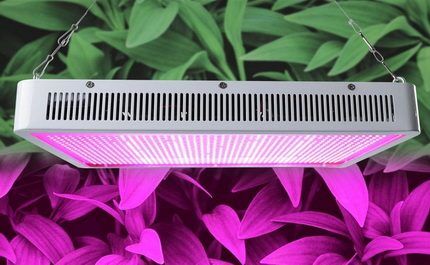
It should be understood that destruction occurs only within the reach of the rays, which, unfortunately, are not able to penetrate very deeply into the wall or upholstery of upholstered furniture. To combat microorganisms, exposures of varying duration are required. It is tolerated worst of all by sticks and cocci. The most resistant to ultraviolet radiation are protozoan microorganisms, spore bacteria and fungi.
However, if you choose the irradiation time wisely, you can completely disinfect the room. This will take an average of 20 minutes.During this time, you can get rid of pathogens, mold and fungal spores, etc.
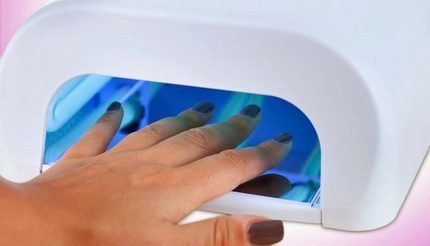
The operating principle of a standard UV lamp is extremely simple. It is a flask filled with mercury gas. Electrodes are attached to its ends.
When voltage is applied, an electric arc is formed between them, which evaporates the mercury, which becomes a source of powerful light energy. More information on mercury-containing lamps cited here.
Depending on the design of the device, its main characteristics differ.
Type #1 - quartz emitting devices
The bulb for these lamps is made of quartz, which has a direct impact on the quality of their radiation. They emit rays in the “hard” UV range of 205-315 nm. For this reason, quartz devices have an effective disinfecting effect.
They cope very well with all known bacteria, viruses, other microorganisms, unicellular algae, spores of various types of mold and fungi.
You need to know that UV waves with a length of less than 257 nm activate the formation of ozone, which is considered the strongest oxidizing agent. Thanks to this, during the disinfection process, ultraviolet light acts together with ozone, which makes it possible to destroy microorganisms quickly and effectively.
However, such lamps have a significant disadvantage. Their exposure is dangerous not only for pathogenic microflora, but also for all living cells.This means that during the disinfection process, animals, people and plants must be removed from the lamp's area of effect. Given the name of the device, the disinfection procedure is called quartzization.
It is used for disinfection of hospital wards, operating rooms, catering establishments, industrial premises, etc. The simultaneous use of ozonation makes it possible to prevent the development of pathogenic microflora and rotting, and to preserve the freshness of products in warehouses or stores longer. Such lamps can be used for therapeutic purposes.
Type #2 - bactericidal ultraviolet emitters
The main difference from the device described above is the material of the flask. For bactericidal lamps it is made of uviol glass. This material blocks “hard” waves well, so ozone is not formed during equipment operation. Thus, disinfection is carried out only due to the influence of safer soft radiation.

Such devices do not pose a great threat to people and animals, but the time and exposure to pathogenic microflora should be significantly increased. Such devices are recommended for use at home.
In medical institutions and similar institutions, they can function continuously. In this case, it is necessary to cover the lamps with a special casing, which will direct the glow upward.
This is necessary to protect the eyesight of visitors and workers. Germicidal lamps are absolutely safe for the respiratory system, since they do not emit ozone, but are potentially harmful to the cornea of the eye.
Prolonged exposure to it can lead to burns, which will eventually lead to deterioration of vision. For this reason, it is advisable to use special glasses to protect your eyes while operating the device.
Type #3 - amalgam type devices
Improved and therefore safer to use ultraviolet lamps. Their peculiarity is that the mercury inside the flask is not present in a liquid state, but in a bound state. It is part of the solid amalgam covering the inner surface of the lamp.
Amalgam is an alloy of indium and bismuth with the addition of mercury. During the heating process, the latter begins to evaporate and emit ultraviolet radiation.
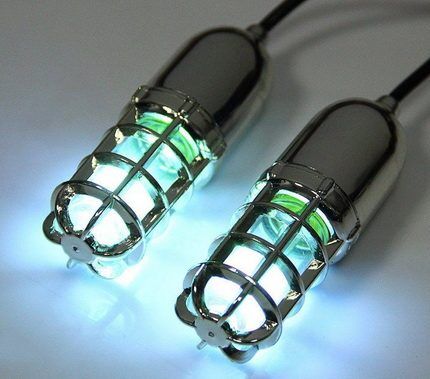
During the operation of amalgam-type devices, the emission of ozone is excluded, which makes them safe. The bactericidal effect is very high. The design features of such lamps make them safe even in case of careless handling.
If the cold flask is broken for any reason, you can simply throw it in the nearest trash container.
If the integrity of the burning lamp is damaged, everything is a little more complicated. Mercury vapor will come out of it because the amalgam is hot. However, their number is minimal and they will not cause harm.
In comparison, if a germicidal or quartz device breaks, there is a real threat to health. Each of them contains about 3 g of liquid mercury, which can be dangerous if spilled. For this reason, entire mercury-containing lamps must be disposed of in a special way.If the light bulb is damaged, then the place where the mercury is spilled is treated by specialists.
Another advantage of amalgam appliances is their durability. Compared to analogues, their service life is at least twice as long. This is due to the fact that the flasks, coated with amalgam on the inside, do not lose their transparency. Whereas lamps with liquid mercury gradually become covered with a dense, slightly transparent coating, which significantly reduces their service life.
What to look for when choosing a device?
Before deciding to purchase a device, you should determine exactly whether it is really necessary. The purchase will be completely justified if there are some indications. The lamp can be used to disinfect premises, water, common objects, etc.
You need to understand that you shouldn’t get too carried away with this, since living in sterile conditions has a very adverse effect on the immune system, especially in children.

Therefore, doctors recommend judicious use of the device in families with frequently ill children during seasonal illnesses. The device will be useful in the process of caring for bedridden patients, since it allows not only to disinfect the room, but also helps fight bedsores, eliminates unpleasant odors, etc.
A UV lamp can cure some diseases, but in this case it is used only on the recommendation of a doctor.
Ultraviolet helps with inflammation of the ENT organs, dermatitis of various origins, psoriasis, neuritis, rickets, influenza and colds, in the treatment of ulcers and difficult-to-heal wounds, and gynecological problems.
It is possible to use UV emitters at home for cosmetic purposes. In this way you can get a beautiful tan and get rid of skin problems, dry your nails coated with a special varnish.
In addition, special lamps for water disinfection and devices that stimulate the growth of house plants are produced. All of them have specific features that prevent them from being used for other purposes. Thus, the range of household UV lamps is very large.
There are quite a few universal options among them, so before purchasing you need to know exactly for what purposes and how often the device will be used.

In addition, there are a number of factors that must be taken into account when choosing.
Type of household UV lamp
Manufacturers produce three types of equipment for working at home:
- Open lamps. Ultraviolet radiation from the source spreads unhindered. The use of such devices is limited by the characteristics of the lamp. Most often, they are turned on for a strictly defined time; animals and people are removed from the premises.
- Closed devices or recirculators. The air is supplied inside the protected housing of the device, where it is disinfected, and then enters the room. Such lamps are not dangerous to others, so they can work in the presence of people.
- Specialized equipment, designed to perform specific tasks. Most often it is equipped with a set of tube attachments.
Experts recommend choosing specialized or closed devices, as they are the safest. Open equipment requires constant monitoring and strict adherence to the rules for its use.
Device mounting method
The manufacturer suggests choosing a suitable model from two main options: stationary and mobile. In the first case, the device is secured to the location chosen for this purpose. No relocations are planned.
Such devices can be fixed to the ceiling or wall. The last option is more popular. A distinctive feature of stationary devices is their high power, which allows them to process a room of large area.
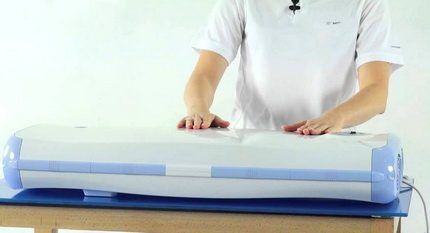
Most often, closed recirculator lamps are produced in this design. Mobile devices are less powerful, but can be easily moved to another location.
These can be either closed or open lamps. The latter are especially convenient for disinfecting small spaces: wardrobes, bathrooms and toilets, etc. Mobile devices are usually installed on the floor or on tables, which is quite convenient.
Moreover, floor-standing models have greater power and are quite capable of processing a room of impressive size. Most of the specialized equipment is mobile. Interesting models of UV emitters have appeared relatively recently.These are unique hybrids of a lamp and a bactericidal lamp with two operating modes. They work as lighting devices or disinfect a room.
UV emitter power
To use a UV lamp correctly, it is important that its power matches the size of the room in which it will be used.
The manufacturer usually indicates the so-called “room coverage” in the technical data sheet of the product. This is the area that is affected by the device. If there is no such information, the power of the device will be indicated.
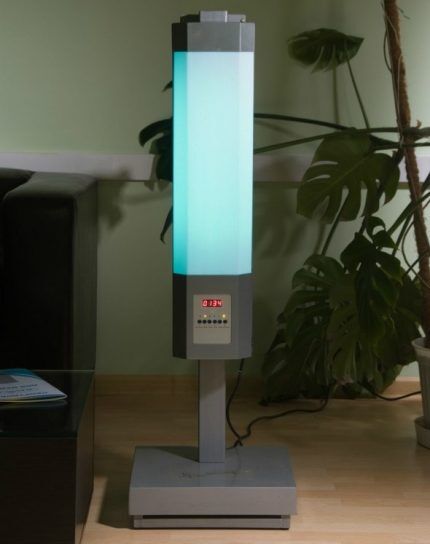
On average for rooms up to 65 cubic meters. m, a 15 W device will be sufficient. This means that such a lamp can be safely purchased if the area of the rooms being treated is from 15 to 35 square meters. m with a height of no more than 3 m. More powerful specimens producing 36 W should be purchased for rooms with an area of 100-125 cubic meters. m at standard ceiling heights.
The most popular models of UV lamps
The range of ultraviolet emitters intended for home use is quite wide. Domestic manufacturers produce high-quality, efficient and quite affordable equipment. Let's consider several such devices.
No. 1 - various modifications of the Solnyshko brand
Under this brand, open-type quartz emitters of various powers are produced. Most models are designed for disinfection of surfaces and spaces whose area is no more than 15 square meters. m.
In addition, the device can be used for therapeutic irradiation of adults and children over three years of age.The device is multifunctional, therefore it is considered universal.
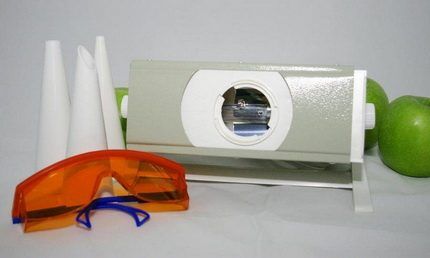
The case is equipped with a special protective screen, which is used during medical procedures and is removed when disinfecting the room. Depending on the model, the equipment is equipped with a set of special attachments or tubes for various therapeutic procedures.
Since the device can be considered an open-type emitter, it is necessarily equipped with safety glasses and a biodosimeter, which helps ensure that the radiation dose is not exceeded.
Let's get acquainted with Sun UV lamps:
No. 2 - compact emitters Crystal
Another example of domestic production. It is a small mobile device. Intended exclusively for disinfection of spaces whose volume does not exceed 60 cubic meters. m.
These parameters correspond to a room of standard height with an area of no more than 20 square meters. m. The device is an open type lamp, and therefore requires proper handling.
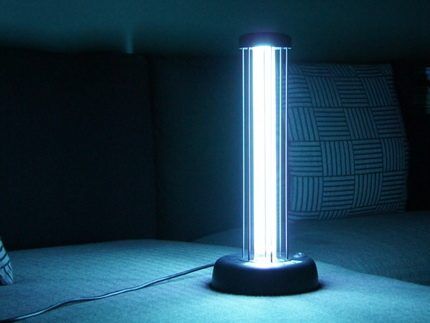
While the equipment is operating, plants, animals and people must be removed from the area of its operation. Structurally, the device is very simple. There is no timer or automatic shutdown system. For this reason, the user must independently monitor the operating time of the device.
If necessary, the UV lamp can be replaced with a standard one luminescent and then the equipment will work like a regular lamp.
How does the Crystal bactericidal lamp work:
No. 3 - bactericidal recirculators of the RZT and ORBB series
These are powerful closed-type devices. Designed for disinfection and air purification. The devices are equipped with a UV lamp, which is located inside a closed protective housing.
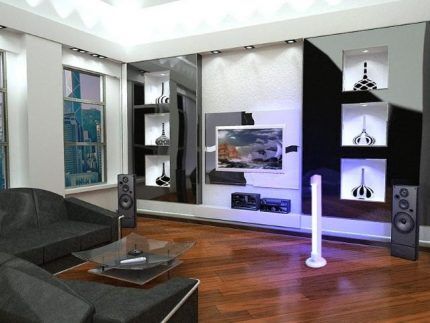
Air is sucked into the device by a fan, and after processing it is supplied outside. Thanks to this, the device can operate in the presence of people, plants or animals without being negatively affected.
Depending on the model, the devices may be additionally equipped with filters that trap particles of dirt and dust. The equipment is mainly produced in the form of stationary devices with wall mounting; there are also ceiling versions. In some cases, the device can be removed from the wall and placed on a table.
Conclusions and useful video on the topic
Choosing the right UV emitter for your home:
Ultraviolet light is necessary for every living creature. Unfortunately, it is not always possible to obtain it in sufficient quantities. In addition, UV rays are a powerful weapon against a wide variety of microorganisms and pathogenic microflora. Therefore, many people are thinking about buying a household ultraviolet emitter.
When making a choice, do not forget that you need to use the device extremely carefully. It is necessary to strictly follow the recommendations of doctors and not to overdo it. Large doses of ultraviolet radiation are very dangerous for all living things.
Would you like to share your experience using a UV lamp at home? Write your opinion about the device - are you satisfied with this manufacturer and the quality of disinfection?
Or are you just planning a purchase and have questions or doubts about the advisability of purchasing an ultraviolet disinfectant? Ask our experts for advice in the block below this article - we will try to help you.
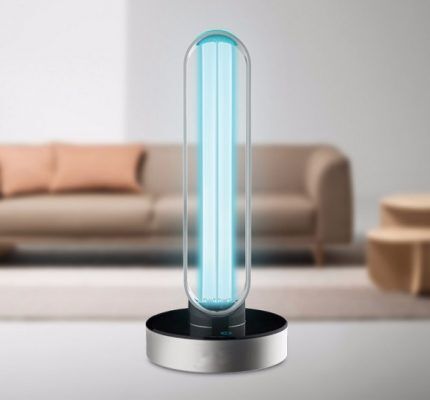




Standard bactericidal lamps belong to the category of gas-discharge devices. They are distinguished from quartz by the material used to make the flask - instead of quartz glass, they use uviol glass. It blocks aggressive radiation that forms ozone. They are distinguished from amalgam lamps by the presence of mercury in a free state. This type of device is absolutely safe for treating apartments, but is less effective than quartz lamps.
In moderate doses, the human body needs ultraviolet radiation, which promotes the production of vitamin D. Under normal conditions, it is enough to take sunbathing to replenish the deficiency of this vitamin in the body. But in winter there is not much sun. However, it is enough to buy an ultraviolet lamp for home use to solve this problem.
Too much vitamin D is just as harmful as too little. As soon as a tan begins to appear, it means that the body began to produce a pigment that protects against UV radiation. Therefore, there was an excess of vitamin D...